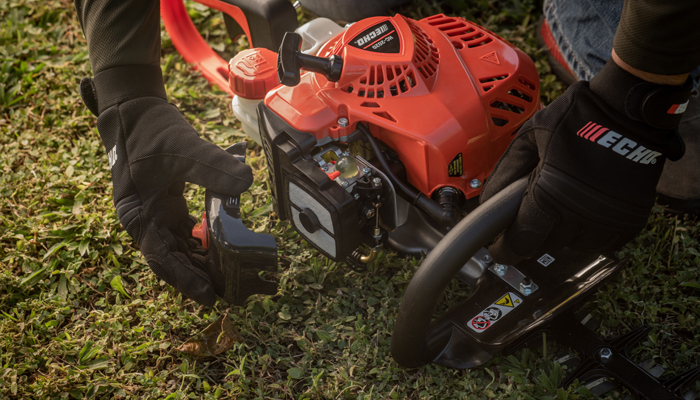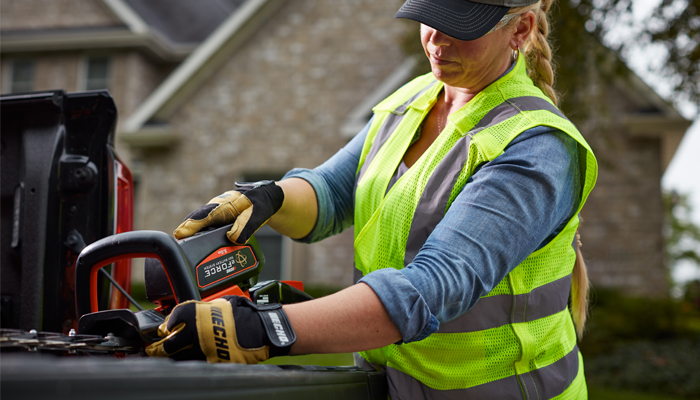Hedge Trimmer Maintenance
Hedge trimmer maintenance can be intimidating if you’re doing it for the first time, but it doesn’t have to be a daunting experience if you know what to do. Not to mention, proper care and maintenance can save you money and time and extend the life of all your power tools.
Maintenance is essential to keeping tools safe, efficient, and long-lasting – and with the right guidance and information, you can do almost all of it with confidence. Regularly inspecting, cleaning, and maintaining your hedge trimmer does more than just improve cutting performance and prolong tool life. It also helps prevent starting issues and expensive future repair or replacement costs. And ECHO YOUCAN™ maintenance kits make the job easy and quick.
Read on to learn everything you need to know about hedge trimmer maintenance. From basic inspection and cleaning tips to sharpening a hedge trimmer, we’re covering it all.
Routine Inspection and Cleaning
All power tools benefit from routine inspection and cleaning – your hedge trimmer is no different. Simple hedge trimmer maintenance tasks help identify signs of wear, damage, or debris build-up that can keep your trimmer from performing at its best.
Routine maintenance tasks can include cleaning your trimmer after each use to remove grass or brush clippings, dirt, or any other debris that can negatively impact performance. Other important tasks include lubricating moving parts and tightening loose bolts or screws. These quick, easy maintenance jobs keep trimmers in peak condition for years of use.
Air Filter
Regular maintenance on your ECHO hedge trimmer air filter ensures optimal performance and longevity of your tool. A clean air filter keeps your trimmer running smoothly and prevents dirt and debris from getting into the engine.
Tips for inspecting and maintaining your air filter:
- Inspection: Make sure your hedge trimmer is turned off or disconnected from its power source and that the tool is completely cooled. Unscrew or unlatch the cover and carefully remove the filter to inspect it for damage, dirt, or wear.
- Cleaning: If the filter is just slightly dirty, you can gently tap it to jar loose any caked on dirt. For a more thorough cleaning, you can wash it with a mild soap and warm water – make sure the filter is completely dry before replacing it in your hedge trimmer.
- Replacement: If the filter is damaged, excessively dirty, or worn, it’s time to replace it. Make sure you check the size and get the recommended ECHO air filter for your specific model hedge trimmer. Reinstall your new filter and secure the cover back in place.

Recoil Starter Rope
The recoil starter rope is vital to the hedge trimmer’s engine and allows easy starting with a quick pull. Periodic inspection of the recoil starter rope will alert you to any fraying or other damage that could cause malfunction or injury.
Tips for inspecting and maintaining the recoil starter rope:
- Regular inspection: Look for signs of wear, damage, or fraying, as well as kinks, knots, or tangles.
- Cleaning: Remove dirt, debris, clippings, or build-up with a soft brush or by blowing compressed air.
- Winding: The recoil rope should be wound around the starter pulley with care – be sure not to overwind or wind unevenly, which can lead to tangles.
- Lubrication: Applying a very small amount of lubricant to the recoil starter mechanism (including the pulley and spring) can ensure clean, smooth operation with every use. Take care not to over-lubricate – too much lubrication will attract dirt and debris.
- Replacement: If you notice signs of fraying or significant damage, replace the recoil starter rope immediately – failure to do so can lead to a need for more extensive and often expensive repairs.
Spark Plugs
Gas-powered hedge trimmers, unlike their battery-powered counterparts, are equipped with spark plugs that require regular cleaning, maintenance, and replacement.
Spark plugs ignite the air-to-fuel mixture in the engine cylinder of your hedge trimmer. Making sure spark plugs are clean and working correctly is essential for combustion, engine operation, and starting power. If not maintained and replaced regularly, faulty or old spark plugs can have a negative impact on your tool’s performance.
With just a little bit of care, your battery-operated string trimmer will always be ready to trim. The following guidelines will keep your ECHO string trimmer battery in excellent condition, so your tool is reliable when you need it.
Tips for inspecting and maintaining spark plugs:
- Inspection: Look for signs of wear or damage. You can remove spark plugs with a specific spark plug wrench.
- Cleaning: Clean with a wire brush and solvent to remove debris.
- Replacement: Replace any spark plugs that are worn or damaged.
Fuel System
If you own a gas-powered hedge trimmer, regularly inspecting and maintaining the fuel system is crucial. Checking the fuel system prevents starting issues and ensures your tool is reliable when you need it.
To inspect and maintain the fuel system in your gas-powered hedge trimmer:
- Regularly inspect: Check the fuel tank, lines, and filter for signs of leaks, damage, or any contamination.
- Replace the fuel filter: To ensure accurate fuel flow, replace the fuel filter when it looks dirty or clogged.
- Inspect fuel lines: Carefully check fuel lines for signs of cracks, leaks, or deterioration. If found, replace the line immediately.
- Clean the fuel tank: From time to time, clean the fuel tank to remove sediment, debris, or any water that may have accumulated in it.
- Run engine regularly: Starting your hedge trimmer periodically and letting it run for a few minutes helps to circulate fuel through the system.
- Store your hedge trimmer: When storing a hedge trimmer for an extended time – like between seasons – drain the fuel tank completely or use a fuel stabilizer.
Battery
Battery-powered hedge trimmers deliver consistent power when the battery is cared for the right way. They’ll remain reliable and in top condition for years to come and consistently meet all your trimming needs.

Tips for caring and maintaining your hedge trimmer’s battery:
Charging best practices:
- Get professional grade battery power with ECHO 56V batteries, chargers, and accessories.
- Avoid overcharging your battery, which will drastically reduce its lifespan.
- When the battery is fully charged, remove it immediately from the charger.
- Always charge a battery in a well-ventilated area and away from flammable materials.
Storage recommendations:
- Store your hedge trimmer’s battery in a cool, dry place, away from extreme temperatures or direct sunlight – low temperatures can affect a battery’s performance, and high temperatures can degrade a battery over time.
- When storing your hedge trimmer for an extended time, remove the battery to prevent self-discharge and extend its lifespan.
- Stored batteries should be at about 50% capacity – avoid storing a battery that’s either fully charged or completely depleted.
Battery maintenance:
- Regularly clean the battery contacts and terminals with a dry, soft cloth. Removing debris will help create a secure connection for optimal force and power.
- Look for signs of wear, including cracks or leaks. If you find damage, you’ve noticed a significant decline in power, or your battery no longer holds its charge, it might be time to replace it.. Contact ECHO customer support for assistance.
How to Sharpen a Hedge Trimmer
Sharp blades are critical for effective, efficient trimming. Knowing how to sharpen a hedge trimmer will maintain the health of your hedges and your tool. If you see uneven, unclean, or frayed branch edges after you cut, your trimmer probably needs to be sharpened.
Tips for sharpening a hedge trimmer:
- Start and then stop the trimmer to offset the blade and guard so there’s space between them.
- Make sure there is no power source on your trimmer – remove the battery if possible.
- Clean the teeth to remove plant sap, debris, and any accumulated resin.
- Use a sharpening stone or file to sharpen each blade, filing toward the cutting edge carefully – you want to maintain the angle of the original cutting edge.
- Use the same number of file strokes on each edge to ensure every blade is the same length.
- Test your trimmer’s sharpness by making a few cuts on scrap wood.
Keep Your ECHO Hedge Trimmer Working Like a Pro
With the right hedge trimmer maintenance and upkeep, your trimmer will offer clean, sharp, exact cuts every time you use it. Use the information here to create a regular inspection and cleaning plan for every part of your trimmer.
Check out Echo’s hedge trimmer blade protector to keep your trimmer sharp season after season.
